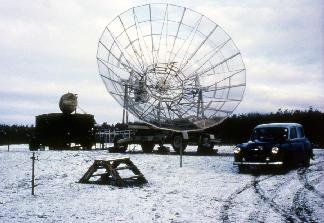The MKI and the discovery of Quasars
A series of observations linked with small telescopes across the country showed that a number of radio sources had exceedingly small angular size. These were shown to be a great distance and became known as QUASARS.
A series of experiments, begun in the late 1950's, were instrumental in the discovery of Quasars. Small portable telescopes, such as that shown above, were taken to increasingly more distant sites from Jodrell Bank. The signals they received whilst observing a radio source were tranmitted over Microwave Radio Links to Jodrell where they were combined with the signals from the same source received by the MKI Telescope. Together these two telescopes made up what is called a Radio Interferometer. Both telescopes looked due South and observed the radio source as it passed through their beams.
By combining the signals from both telescopes a fringe pattern is produced with the signal oscillating up and down at a rate which depends on the spacing of the telescopes. However, if the angular size of the radio source is greater than the fringe pattern, the amplitude of the signal is reduced and for even larger sources will disappear completely.
Initially the radio sources were observed with the telescopes relativly close together. In this case the fringe pattern is very broad and greater than the typical angular size of radio sources so virtually all are observed to give fringes. However as the telescopes are moved apart, the fringe spaceing becomes finer and the fringes from many of the radio sources first reduced in amplitude and then disappeared. The separation of the telescopes when the fringes from each source reduced in amplitude (and the wavelength of the radio waves observed) allowed the angular size of the radio sources to be found.
To the surprise of the astronomers quite a number were found to have exceedingly small angular sizes - so small in fact that their images on a photographic plate would look like the images of stars. Much work then went into finding the precise location of these objects and finally it was possible to obtain their spectra. They were nothing like the spectra of stars or galaxies and remained a puzzle for some time. Finally it was realised that the reason that the spectra were so different was that the objects were so far away that their light was greatly red shifted. They were at very great distances away from us and so it was not surprising that their images were so small!
Because their images looked liked those of stars they were called Quasi-Stellar-Objects or QUASARS for short.



